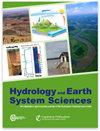A pulse-decay method for low (matrix) permeability analyses of granular rock media
IF 5.8
1区 地球科学
Q1 GEOSCIENCES, MULTIDISCIPLINARY
引用次数: 0
Abstract
Abstract. Nanodarcy level permeability measurements of porous media, such as nano-porous mudrocks, are frequently conducted with gas invasion methods into granular-sized samples with short diffusion lengths and thereby reduced experimental duration; however, these methods lack rigorous solutions and standardized experimental procedures. For the first time, we resolve this by providing an integrated technique (termed gas permeability technique, GPT) with coupled theoretical development, experimental procedures, and data interpretation workflow. Three exact mathematical solutions for transient and slightly compressible spherical flow, along with their asymptotic solutions, are developed for early- and late-time responses. Critically, one late-time solution is for an ultra-small gas-invadable volume, important for a wide range of practical usages. Developed to be applicable to different sample characteristics (permeability, porosity, and mass) in relation to the storage capacity of experimental systems, these three solutions are evaluated from essential considerations of error difference between exact and approximate solutions, optimal experimental conditions, and experimental demonstration of mudrocks and molecular-sieve samples. Moreover, a practical workflow of solution selection and data reduction to determine permeability is presented by considering samples with different permeability and porosity under various granular sizes. Overall, this work establishes a rigorous, theory-based, rapid, and versatile gas permeability measurement technique for tight media at sub-nanodarcy levels.用于粒状岩石介质低(基质)渗透性分析的脉冲衰减法
摘要。多孔介质(如纳米多孔泥岩)的纳米级渗透率测量通常采用气体侵入粒状样品的方法进行,这种方法的扩散长度短,从而缩短了实验时间;然而,这些方法缺乏严格的解决方案和标准化的实验程序。我们首次提供了一种集理论发展、实验程序和数据解释工作流程于一体的综合技术(称为气体渗透技术,GPT),从而解决了这一问题。我们针对瞬态和轻微可压缩球形流开发了三种精确的数学解法,以及它们的渐近解法,用于早期和晚期响应。重要的是,其中一个晚期解法是针对超小气体不可消散体积的,这对广泛的实际应用非常重要。为了适用于与实验系统存储能力有关的不同样品特征(渗透率、孔隙度和质量),我们从精确解与近似解之间的误差差异、最佳实验条件以及泥岩和分子筛样品的实验演示等基本考虑因素出发,对这三种解决方案进行了评估。此外,考虑到不同颗粒大小的样本具有不同的渗透率和孔隙率,提出了一套实用的解决方案选择和数据还原工作流程,以确定渗透率。总之,这项工作为亚纳米级致密介质建立了一种严谨、基于理论、快速、通用的气体渗透率测量技术。
本文章由计算机程序翻译,如有差异,请以英文原文为准。
求助全文
约1分钟内获得全文
求助全文
来源期刊

Hydrology and Earth System Sciences
地学-地球科学综合
CiteScore
10.10
自引率
7.90%
发文量
273
审稿时长
15 months
期刊介绍:
Hydrology and Earth System Sciences (HESS) is a not-for-profit international two-stage open-access journal for the publication of original research in hydrology. HESS encourages and supports fundamental and applied research that advances the understanding of hydrological systems, their role in providing water for ecosystems and society, and the role of the water cycle in the functioning of the Earth system. A multi-disciplinary approach is encouraged that broadens the hydrological perspective and the advancement of hydrological science through integration with other cognate sciences and cross-fertilization across disciplinary boundaries.
 求助内容:
求助内容: 应助结果提醒方式:
应助结果提醒方式:


